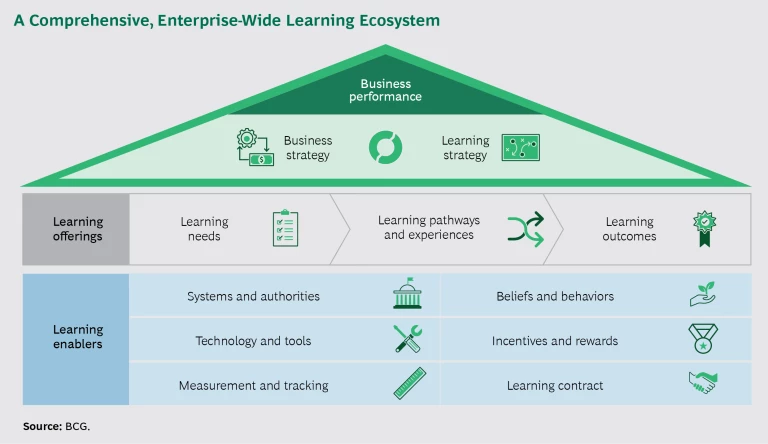Imagine: You have gathered your employees in a conference room for a routine meeting. Suddenly, the doors are thrown open and one of those idiomatic 800-pound gorillas enters—and claims—the space. This particular 800-pound gorilla has a name: Digital. And digital is not going to get back into its cage.
The arrival of digital is a major upheaval—a chest-beating threat to traditional ways of working. As more and more jobs are automated, employees and governments worry about unemployment—or worse, unemployability. And as digital introduces new opportunities, employers worry about finding employees to pursue them. Nearly half of US and German companies reported the lack of qualified employees as the biggest constraint to a full digital transformation. You’re the CEO and it’s up to you to respond to all these concerns. What are you going to do?
This disruption requires that people and enterprises adopt new ways of working. And that requires an innovative approach to learning at work. Learning is survival-critical for employees and enterprises alike. If you fail to establish new ways of learning, you can’t achieve new ways of working; and absent those, you can’t compete. To avoid that fate in the digital age, you need an adaptable learning ecosystem that elevates learning strategy to the CEO level and embraces digital.
The New “Workscape”
The world is poised for what is likely to be the most disruptive change since the Industrial Revolution. On the one hand, digital is creating a need for employees with a fresh set of skills, and employers are struggling to find and retain that talent. And on the other, artificial intelligence, virtual reality, and machine learning will continue to produce machines capable not only of completing simple tasks but of commandeering the creative and intellectual work that humans have long considered theirs alone. There are many predictions about the number of jobs automated or unfilled and the percentage of employees whose jobs are threatened. One such prediction foresees a potential impact of $10 trillion in lost GDP over 20 years from skill imbalances. Regardless of the exact numbers, CEOs need to recognize that the coming change is real, enormous, and game changing.
Projections about job losses can make for a gloomy employment outlook. One view is that the rise of digital is inexorably reducing the need for some employees and the roles of others. Another view: the rise of digital won’t necessarily lead to the elimination of employees; rather, it will force a reexamination and reimagining of the best ways for humans to deliver value to organizations. They will still be employees, but they’ll be doing different jobs—like scrum master or digital venture strategist—in different ways. This will mean identifying particular knowledge, skills, and mindsets that require the “human touch.”
We subscribe to that second, more optimistic view: it’s appropriate—and crucial—to redefine employee roles amid, throughout, and beyond the impending digital change. It will probably be messy, like all change. But as with all good change efforts, it’s critical that CEOs get ahead of the change and shape it, rather than let their organizations be shaped by it.
It’s critical that CEOs get ahead of the change and shape it, rather than let their organizations be shaped by it.
Technology is not just transforming and overtaking work tasks. It is also part of a confluence of forces, including socioeconomic trends and the adoption of agile, that are changing ways of working. Freelance employment and the gig economy are on the rise. Employees are increasingly pushed toward self-directed models that emphasize autonomy, and mobile work is becoming more common. In many cases, employees can do their jobs anytime, anywhere. A redefinition of work, and learning at work, must be considered against this backdrop.
The New “Learnscape”: Learning in the Workflow
Alongside the changes in ways of working, the world is experiencing shifts in ways of learning. Learning and education once consisted of classroom instruction, rote memorization, and capstones such as high school graduation. But in a world of dynamic change, learning must become more dynamic too.
Current education systems and training models cannot provide employees with reliable, lasting skills. By the time students graduate from college and join the workforce, many of the skills they have learned are already out of date, given the blistering pace of change. This means that learning can no longer happen in the first decades of life in preparation for the rest of life; rather, the best employees will be learning throughout their lives, and this learning will take place at work.
To meet these evolving educational needs, CEOs should initiate what we call “learning in the workflow,” and these efforts must be:
- Adaptive and personalized to individual users and their specific needs
- Always-on, with real-time support and feedback
- “Gamified,” with social elements that create “learner pull” to encourage learners to participate
- Measurable, translating to outcomes both for the learners and for the enterprise
The fact that ways of working are changing provides a prime opening to introduce innovative ways of learning as well. Employees are becoming accustomed to change, to self-direction, and to a different relationship with employers and managers (who will each serve new roles in advancing learning). It’s now more possible than ever to create learning-on-the-job paradigms that mesh education and employment and emphasize lifelong learning, preparing individuals for the ongoing changes.
How to Access Digital-Age Skills
Enterprises that are in need of a digital-age skill set can access it in four main ways. They can buy it (by hiring employees with the needed skills), borrow it (by engaging temporary or contract employees), open-source it (by tapping the gig economy), or build it (by developing the skills in-house).
Buying, borrowing, and open-sourcing probably seem like the quickest and simplest solutions, but the required skills are already in heavy demand. So these solutions will be increasingly elusive and, as a result, prohibitively expensive.
Buying, borrowing, or open-sourcing the required capabilities might seem like the best solution—but building them will deliver the biggest payoff.
We believe that building the required skills is a critical component of an enterprise’s strategy and that it will deliver the biggest payoff. It lets an organization hone precisely the skills it needs in ways that will work effectively for its organization without the growing pains of integrating new employees, and it sets the stage for the extension of those skills. Building the skills in-house also sidesteps the cost of simply hiring new people for new roles. (Research has shown that highly paid jobs can have turnover costs of 200% of
As the marketplace continues to evolve and call for up-to-date skills, employees need to find a place to acquire the necessary learning opportunities. Enterprises that address this need can make a learning ecosystem part of their value proposition to attract and retain employees. And when an employer demonstrates dedication to its workforce by investing in education and development, it gains some measure of employee loyalty.
Once a CEO and leadership team decide to build a learning ecosystem, the effort must be comprehensive and deliberate: it must address learning for all employees, be planned in a way that integrates corporate strategy, and have clear metrics as well as rewards for both the enterprise and the employees. It must be adaptable to scenarios where humans work with robots side by side or in some kind of hierarchical relationship. And it must be designed for inevitable change. An adaptable and flexible learning ecosystem will allow for perpetual learning as it too learns and adapts.
A New Learning Ecosystem and the Pillars That Support It
No one can offer a one-size-fits-all solution for enterprises that need to build a learning ecosystem; certainly, customization will be needed at every level. In fact, we don’t believe that a one-size-fits-all solution exists; given the ongoing rapid change, such a solution might always be a moving target, and appropriately so.
With that in mind, one tenet of any enterprise’s approach to learning must be an emphasis on the know-how rather than the simplistic know-what. The learning ecosystem must maintain a focus on this overarching goal: learner-employees need to learn not only specific skills but also the ability to think critically about how to adapt and extrapolate those skills.
Of course, the development of learning ecosystems has already begun, so we can offer some insight into the pathways to success. The new learning ecosystem approach that we envision has particular characteristics, approaches, and tools. It will have a presence at all levels of the organization, with the consistent involvement of the CEO. It will incorporate digital considerations and digital approaches to learning. We envision this deliberate construction as a house. (See the exhibit.) The overarching strategy, which tightly combines business strategy with learning strategy, gives rise to specific learning offerings. The enablers are a foundation for the offerings, which are championed by the CEO.
Building an effective learning ecosystem requires adherence to a set of essential principles that are relevant throughout and fundamental to creating success:
- Learning is a CEO issue. A large-scale, digitally oriented reskilling initiative is a core aspect of continual transformation and requires the CEO’s attention. That attention doesn’t stop once high-level strategy has been established. The CEO must be involved throughout.
- Learning must become part of daily rhythms and routines. Employers designing learning ecosystems should resist the temptation to rely too heavily on traditional learning models like online courses and instead develop experiential programs that encourage learners to get used to learning while on the job.
- Learning has to be embedded in the workflow. There are four essential elements (noted earlier) that must always be present for this to work: the learning must be adaptable, the employees must have constant access to their learning on the job, lessons should incorporate games and be social, and the learning must be measurable.
- Employers and employees should enter into a 21st-century “learning contract.” An agreement—a new kind of social contract for learning—must be in place to outline the ways in which employees and the enterprise will share accountability for learning and align on the pathways and skills in that learning.
- Managers must transform from taskmasters to learning coaches. Managers, in a new role, will have the responsibility and capacity to communicate to employees the skills that have value because they contribute to achieving corporate goals.
- Learning strategies must leverage insights from the cognitive and behavioral sciences. Cutting-edge neuroscience is revealing insights about the way people learn, leading to new techniques that are designed to build on human motivations and learning processes. Learning programs are already taking advantage of these brain science techniques with efficient and influential innovations such as badges to mark progress through multipart tasks and “digital nudges” to encourage behavioral change. This is an active space: education companies are using techniques such as the spacing effect, retrieval practice, and confidence-based learning to improve outcomes.
- Learning must focus on traditionally relevant as well as new skills. The impetus for building the learning ecosystem is the need to teach employees about the latest digital technologies and help them develop new digital skills. But some traditional skills are evergreen (like problem solving, communications, and data analysis) and remain relevant; the learning ecosystem should advance these skills too.
- Enterprises must offer recognition to learner-employees. This principle applies throughout the ecosystem because it encompasses so much: recognizing and respecting the needs and inputs of each employee, providing incentives for learning, and positioning the employer as an issuer of credentials, providing certifications that signal individuals’ valuable accomplishments and prowess to those inside and outside the enterprise.
It’s both possible and imperative to create a successful learning ecosystem. That kind of learning is something we experience in our own company. Our Learning at BCG (LAB) program is a fundamental component of our recruiting, retention, and development strategies throughout the organization and around the world. We all participate in training on a variety of topics year round, and this program helps us with professional and personal development.
Of course, no workplace learning program can or should be an entirely altruistic offering designed simply to ensure that employees have up-to-date skills that keep them marketable. It’s also true, though, that leaders have an obligation to leave their enterprises stronger and more capable than they were when they inherited them. This mandate includes a responsibility to employees and a broader societal obligation to advance development and well-being. Thus, though building a comprehensive digital-age learning ecosystem is a daunting task, doing so is essential for reasons both mission critical and altruistic.
But remember that digital is an indispensable aid to the development of your perpetual-learning system. The ecosystem you create will incorporate learning about digital and about working alongside intelligent machines, and it will use digital learning approaches. When it comes to leading and learning in the digital age, a savvy CEO can and should make the 800-pound gorilla an ally by harnessing its power to improve learning and prepare for change.
The BCG Henderson Institute is Boston Consulting Group’s strategy think tank, dedicated to exploring and developing valuable new insights from business, technology, and science by embracing the powerful technology of ideas. The Institute engages leaders in provocative discussion and experimentation to expand the boundaries of business theory and practice and to translate innovative ideas from within and beyond business. For more ideas and inspiration from the Institute, please visit Featured Insights.








